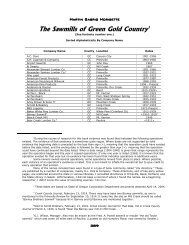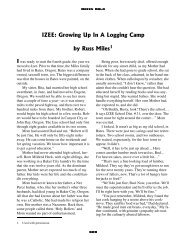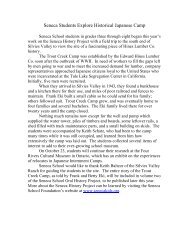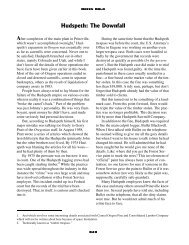09-WB Marshall.pdf - The Seneca School Foundation
09-WB Marshall.pdf - The Seneca School Foundation
09-WB Marshall.pdf - The Seneca School Foundation
You also want an ePaper? Increase the reach of your titles
YUMPU automatically turns print PDFs into web optimized ePapers that Google loves.
ecause I have found no information about them.<br />
<strong>The</strong>y appear only in the list of sawmills. But this<br />
chapter is supposed to be about W. B. <strong>Marshall</strong>,<br />
so back to him.<br />
Very little is known about the man. He<br />
appears to have been unmarried, at least when he<br />
mortgaged his land in 1889 and again in 1891<br />
when he received a plot of public land from President<br />
Benjamin Harrison. 6 <strong>The</strong> best information<br />
on <strong>Marshall</strong> comes from Blanche McClun-Hereford's<br />
account of timber and ranching activities in<br />
the Mill Creek Valley. Although Blanche's article<br />
appears elsewhere in this book, the portion about<br />
<strong>Marshall</strong> is presented again here:<br />
William B. <strong>Marshall</strong>, a single man, was<br />
the first one to live on this place at the foot<br />
of Steen Pillar. He filed on a 160 acre homestead<br />
in 1888. He planted a large orchard<br />
and some of the trees are still bearing fruit.<br />
<strong>The</strong> orchard is a lot smaller now as a lot of<br />
the trees have died and have been removed.<br />
<strong>The</strong> old Mill Creek road used to go right in<br />
front of our house and the orchard was just<br />
above the road. <strong>The</strong> new Mill Creek road,<br />
which was built in 1950, goes above the<br />
orchard. Mr. <strong>Marshall</strong> had a lot of goats<br />
and they were often seen around and on top<br />
of the middle rock. <strong>The</strong> old timers named<br />
the middle rock Goat Rock. Goat Springs, I<br />
think, was also named for Mr.<strong>Marshall</strong>'s<br />
goats.<br />
<strong>Marshall</strong> borrowed money to build a<br />
sawmill which stood just below my house.<br />
This was a pen stock water-powered mill<br />
and could only run when there was ample<br />
water in the creek. <strong>The</strong> saw had only eight<br />
teeth. Mr. Compton soon bought in with<br />
<strong>Marshall</strong>, but they lost both land and mill.<br />
It was sold at public auction to satisfy <strong>Marshall</strong>'s<br />
note. John Combs bought it and sold<br />
land and mill 7 to John Demaris in 1895.<br />
John Demaris, who was my husband's<br />
great uncle, took a 160-acre homestead of<br />
1895. Soon Henry Birdsong bought in and<br />
they became partners in the mill.…<br />
This financial difficulty was a problem not<br />
only for <strong>Marshall</strong> but also for his young partner,<br />
Sam Compton (Sam's story is told elsewhere in<br />
this book). This may have been the end of <strong>Marshall</strong><br />
as a sawmill operator but not so Compton.<br />
Nothing beyond the 1887 advertisement included<br />
here has been found about Mr. <strong>Marshall</strong>.<br />
<strong>Marshall</strong> called his operation “Mill Creek<br />
Sawmill.” That name was used by others which<br />
makes tracking the ownership of <strong>Marshall</strong>'s operation<br />
difficult.<br />
5. This is probably the same location that was eventually owned by the Hudspeth family. <strong>The</strong> business was then called<br />
Prineville Machine Shop.<br />
6. Patent dated October 2, 1891, filed June 2, 1908, recorded in Vol. 3, Patents at page 514, Crook County Clerk’s Office.<br />
7. Mortgage, dated and filed December 19, 1889; recorded Vol. 1 Mortgages at page 737. <strong>The</strong> amount of the mortgage was<br />
$626.50. A marginal note on the mortgage reads, “Foreclosed May 8, 1893; Journal 2, Page 566.”







